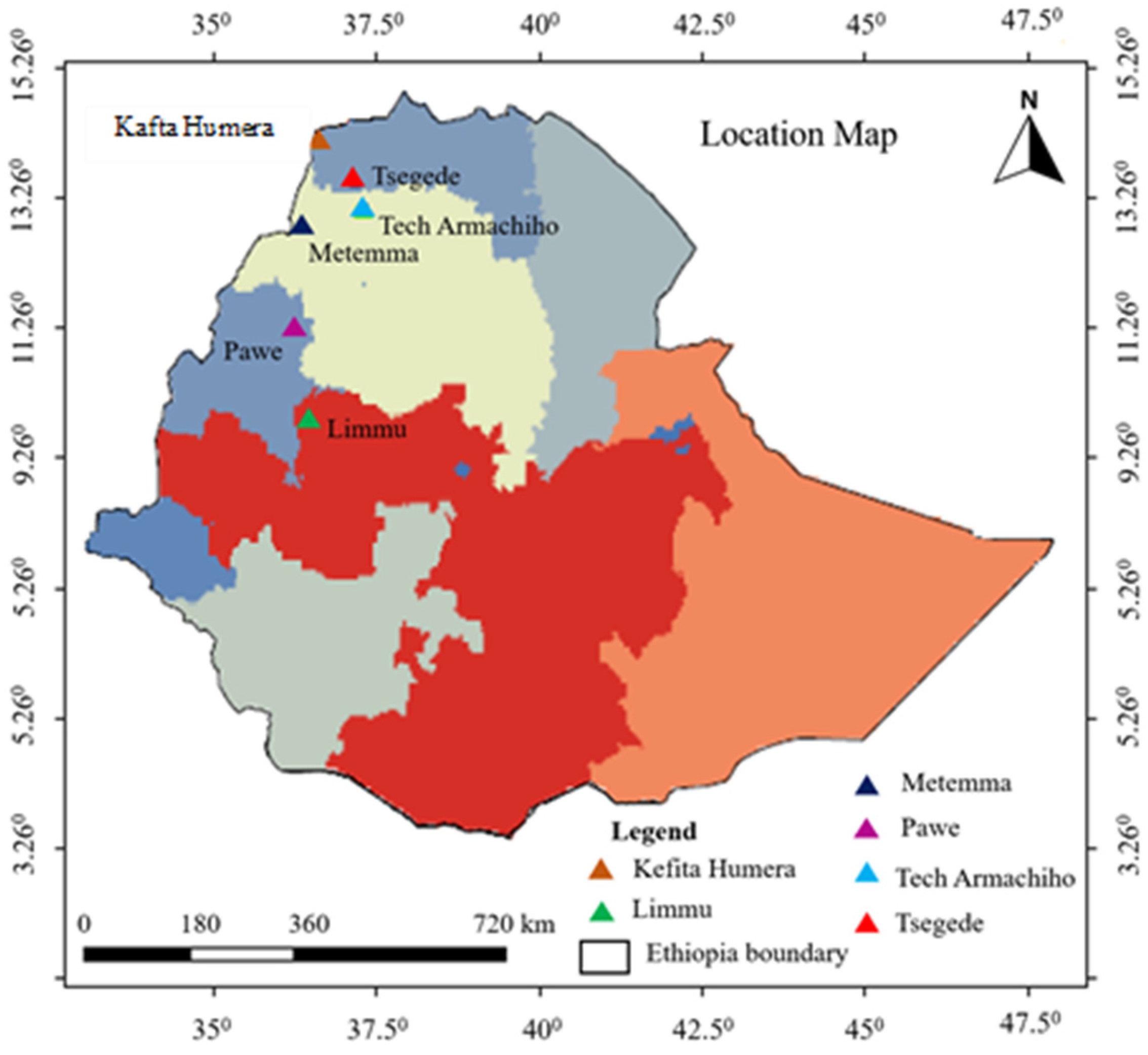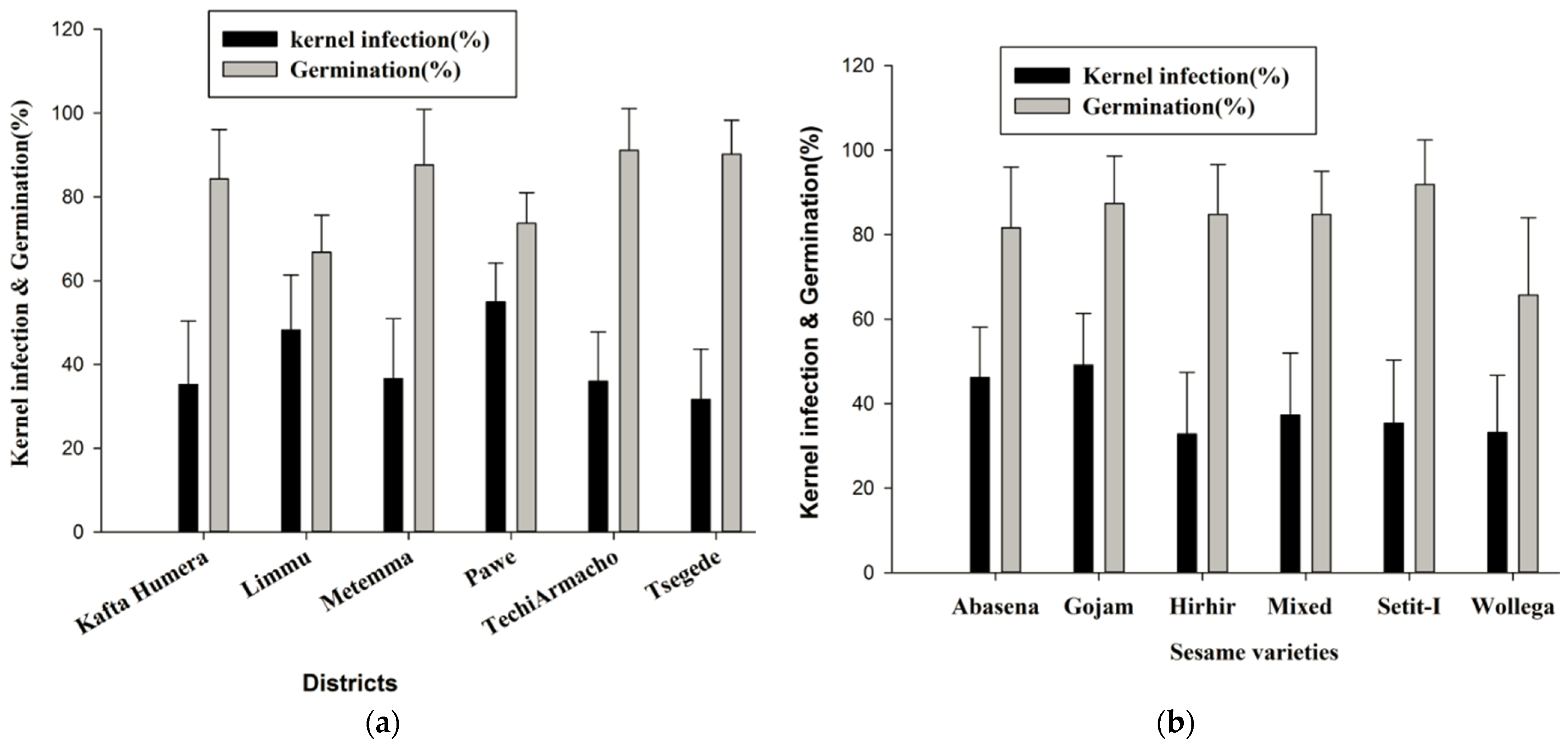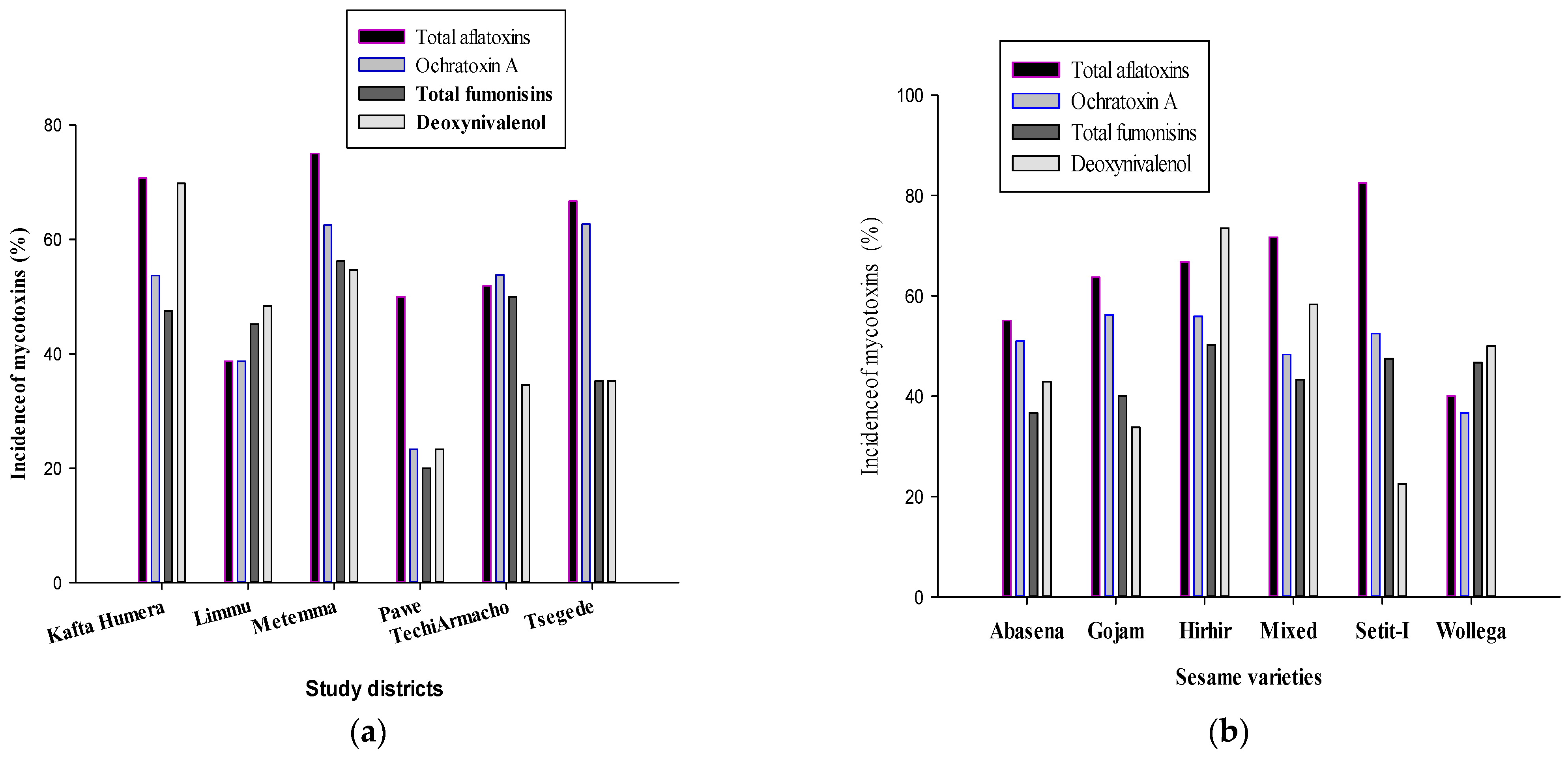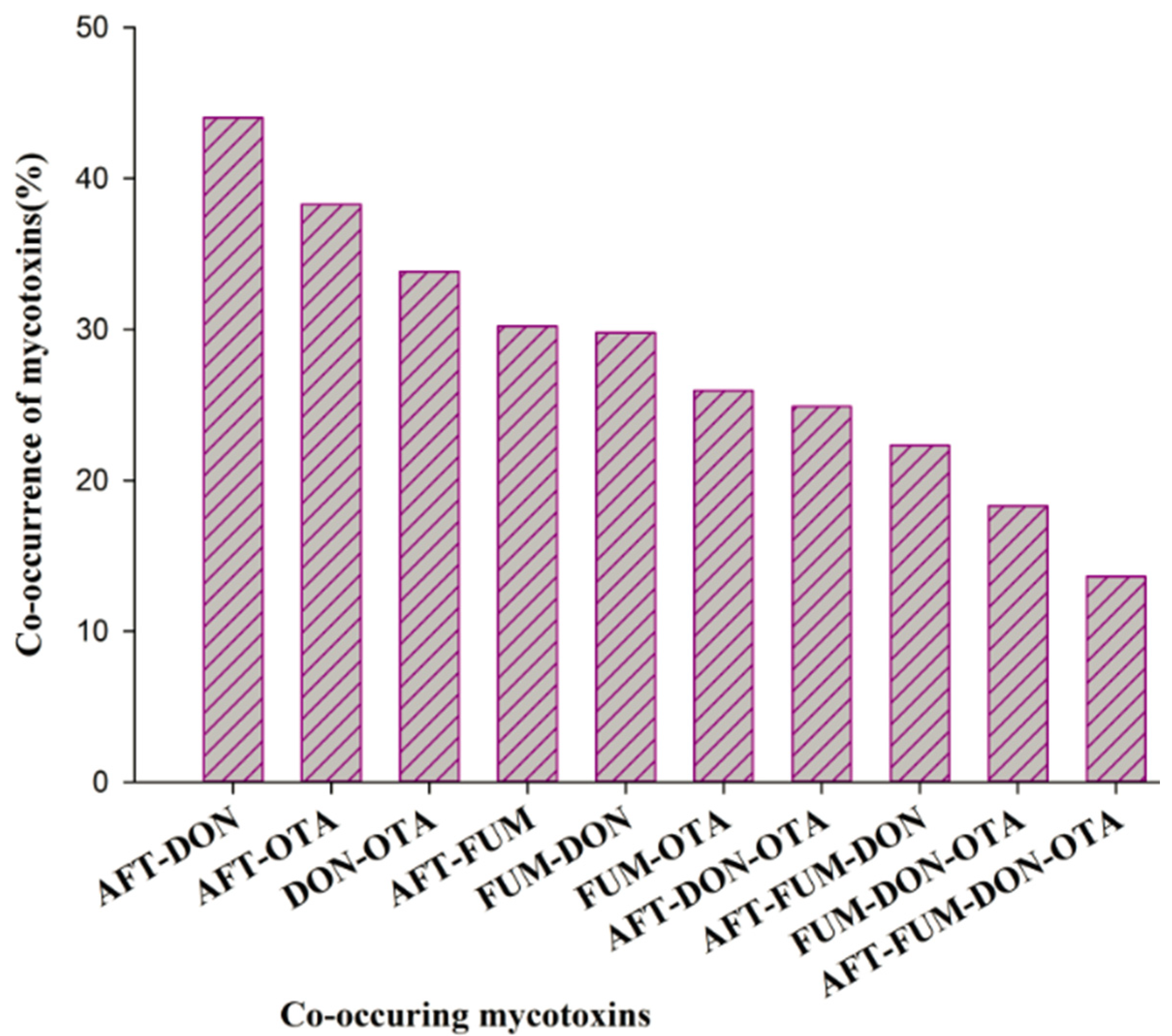Occurrence and Levels of Mycotoxins in On-Farm-Stored Sesame in Major Growing Districts of Ethiopia
Abstract
1. Introduction
2. Materials and Methods
2.1. Description of the Study Areas
2.2. Sample Collection
2.3. Determination of Moisture Contents
2.4. Determination of Kernel Infection by Molds
2.5. Seed Germination Tests
2.6. Preparation of Samples and Analysis of Mycotoxins
2.7. Data Analysis
3. Results
3.1. Moisture Content, Relative Humidity, and Temperature of Sesame Samples
3.2. Seed Germination and Fungal Infection
3.3. Occurrence of Mycotoxins in Sesame across Varieties and Districts in Ethiopia
3.3.1. Total Aflatoxin
3.3.2. Ochratoxin A
3.3.3. Total Fumonisins
3.3.4. Deoxynivalenol
3.4. Co-Occurrence of Mycotoxins
3.5. Discussion
3.6. Conclusions
Author Contributions
Funding
Institutional Review Board Statement
Informed Consent Statement
Data Availability Statement
Conflicts of Interest
References
- UNCTAD (United Nations Conference on Trade and Development). National Green Export Review of Ethiopia: Leather and Sesame Seeds; UNCTAD: Geneva, Switzerland, 2018; p. 57. [Google Scholar]
- FAOSTAT (Food and Agriculture Organization/Statistics Database). Food and Agriculture Organization Statistical Databases. 2023. Available online: http://faostat.fao.org/ (accessed on 5 February 2023).
- Laurentin, H.E.; Karlovsky, P. Genetic relationship and diversity in a sesame (Sesamum indicum L.) germplasm collection using amplified fragment length polymorphism (AFLP). BMC Genet. 2006, 7, 1–10. [Google Scholar] [CrossRef]
- Teklu, D.H.; Shimelis, H.; Tesfaye, A.; Abady, S. Appraisal of the sesame production opportunities and constraints, and farmer-preferred varieties and traits, in eastern and southwestern Ethiopia. Sustainability 2021, 13, 11202. [Google Scholar] [CrossRef]
- Boere, A.; Rutgers, T.; Willems, D.; Kidane, D.; Dolfen, W. Business Opportunities Report: Oilseeds and pulses. In Proceedings of the Ethiopian Netherlands Business Event, Rijswijk, The Netherlands, 5–6 November 2015. [Google Scholar]
- Francom, M.G.; Counselor, A. Ethiopia’s Oilseed Sector Set to Expand; USDA: Washington, DC, USA, 2018; Volume 19, p. 15. [Google Scholar]
- Terefe, G.; Wakjira, A.; Berhe, M.; Tadesse, H. Sesame Production Manual; Ethiopian Institute of Agricultural Research, Embassy of the Kingdom of the Netherlands, EIAR: Addis Ababa, Ethiopia, 2012; p. 49. [Google Scholar]
- Zerihun, J. Sesame (Sesame indicum L.) crop production in Ethiopia: Trends, challenges, and future prospects. Sci. Technol. Arts Res. J. 2012, 1, 1–7. [Google Scholar] [CrossRef]
- Shephard, G.S. Risk assessment of aflatoxins in food in Africa. Food Addit. Contam. 2008, 25, 1246–1256. [Google Scholar] [CrossRef]
- Jeyalakshmi, C.; Rettinassababady, C.; Nema, S. Integrated management of sesame diseases. J. Biopestic. 2013, 6, 68. [Google Scholar]
- Sabry, B.A.; Hathout, A.S.; Nooh, A.; Aly, S.E.; Shehata, M.G. The prevalence of aflatoxin and Aspergillus parasiticus in Egyptian sesame seeds. Int. J. ChemTech Res. 2016, 9, 308–319. [Google Scholar]
- Jimoh, K.O.; Kolapo, A.L. Mycoflora and aflatoxin production in market samples of some selected Nigerian foodstuffs. Res. J. Microbiol. 2008, 3, 169–174. [Google Scholar]
- Wu, F. Mycotoxin Risk Assessment for the Purpose of Setting International Regulatory Standards. Environ. Sci. Technol. 2004, 38, 4049–4055. [Google Scholar] [CrossRef] [PubMed]
- Reddy, K.R.N.; Salleh, B.; Saad, B.; Abbas, H.K.; Abel, C.A.; Sheir, W.T. An overview of mycotoxin contamination in foods and its implications for human health. Toxin Rev. 2010, 29, 3–26. [Google Scholar] [CrossRef]
- Misihairabgwi, J.M.; Ezekiel, C.N.; Sulyok, M.; Shephard, G.S.; Krska, R. Mycotoxin contamination of foods in Southern Africa: A 10-year review (2007–2016). Crit. Rev. Food Sci. Nutr. 2019, 59, 43–58. [Google Scholar] [CrossRef] [PubMed]
- Gulderen, Y.; Bucket, E.; Muzaffer, G.O.; Aysel, B.O. Determination of aflatoxins in peanut butter and sesame samples using a high-performance liquid chromatography method. Eur. Food Res. Technol. 2006, 224, 167–170. [Google Scholar] [CrossRef]
- Li, F.Q.; Li, Y.W.; Wang, Y.R.; Luo, X.Y. Natural occurrence of aflatoxins in Chinese peanut butter and sesame paste. J. Agric. Food Chem. 2009, 57, 3519–3524. [Google Scholar] [CrossRef] [PubMed]
- Idris, Y.M.; Mariod, A.A.; Elnour, I.A.; Mohamed, A.A. Determination of aflatoxin levels in Sudanese edible oils. Food Chem. Toxicol. 2010, 48, 2539–2541. [Google Scholar] [CrossRef] [PubMed]
- Hosseininia, A.R.; Vahabzadeh, M.; Rashedinia, M.; Riahi-Zanjani, B.; Karimi, G. A survey of aflatoxins in sesame seeds imported into Khorasan Province, Iran. Mycotoxin Res. 2014, 30, 43–46. [Google Scholar] [CrossRef] [PubMed]
- Kollia, E.; Tsourouflis, K.; Markaki, P. Aflatoxin B1 in sesame seeds and sesame products from the Greek market. Food Addit. Contam. B 2016, 9, 217–222. [Google Scholar] [CrossRef] [PubMed]
- Fapohunda, S.O.; Anjorin, T.S.; Sulyok, M.; Krska, R. Profile of major and emerging mycotoxins in sesame and soybean grains in the Federal Capital Territory, Abuja, Nigeria. Eur. J. Biol. Res. 2018, 8, 121–130. [Google Scholar]
- Ezekiel, C.N.; Sulyok, M.; Warth, B.; Krska, R. Multi-microbial metabolites in fonio millet (acha) and sesame seeds in Plateau State, Nigeria. Eur. Food Res. Technol. 2012, 235, 285–293. [Google Scholar] [CrossRef]
- Magan, N.; Medina, A.; Aldred, D. Possible climate-change effects on mycotoxin contamination of food crops pre- and post-harvest. Plant Pathol. 2011, 60, 150–163. [Google Scholar] [CrossRef]
- Abbas, H.K.; Ebelhar, M.W.; Bellaloui, N.; Mulvaney, M.J.; Stoner, G.R.D.; Kotowicz, J.K.; Little, N.S.; Accinelli, C.; Shier, W.T. Contamination of sesame seed grown in Mississippi with aflatoxin, fumonisin, and mycotoxin-producing fungi. World Mycotoxin J. 2019, 12, 123–132. [Google Scholar] [CrossRef]
- Bradford, K.J.; Dahal, P.; Van Asbrouck, J.; Kunusoth, K.; Bello, P.; Thompson, J.; Wu, F. The dry chain: Reducing post-harvest losses and improving food safety in humid climates. Trends Food Sci. Technol. 2018, 71, 84–93. [Google Scholar] [CrossRef]
- Mannaa, M.; Kim, K.D. Influence of temperature and water activity on deleterious fungi and mycotoxin production during grain storage. Mycobiology 2017, 45, 240–254. [Google Scholar] [CrossRef]
- Mimoune, N.A.; Riba, A.; Verheecke, C.; Mathieu, F.; Sabaou, N. Fungal contamination and mycotoxin production by Aspergillus spp. In nuts and sesame seeds. J. Microb. Biotech. Food Sci. 2016, 5, 301–305. [Google Scholar] [CrossRef]
- FAO (Food and Agriculture Organization). Worldwide Regulations for Mycotoxins in Food and Feed. In FAO Food and Nutrition Paper 81; FAO/UN: Rome, Italy, 2004. [Google Scholar]
- WHO (World Health Organization). Evaluation of Certain Mycotoxins in Foods. Fifty-Sixth Report of the Joint FAO/WHO Expert Committee on Food Additives; Technical Report No. 906; WHO: New York, NY, USA, 2002. [Google Scholar]
- Williams, J.H.; Phillips, T.D.; Jolly, P.E.; Stiles, J.K.; Jolly, C.M.; Aggarwal, D. Human aflatoxicosis in developing countries: A review of toxicology, exposure, potential health consequences, and interventions. Amer. J. Clin. Nutr. 2004, 80, 1106–1122. [Google Scholar] [CrossRef]
- Zain, M.E. Impact of mycotoxins on humans and animals. J. Saudi Chem. Soc. 2011, 15, 129–144. [Google Scholar] [CrossRef]
- Sahile, S.; Assefa, N. Evaluation of Aflatoxins and Storage Fungi in Sesame, Chickpea and Faba Bean Export Commodities from Gondar Town, North West Ethiopia. Adv. Res. J. Multidiscip. Discov. 2018, 25, 76–82. [Google Scholar]
- Armstrong, P.R.; Maghirang, E.B.; Bhadriraju, S.; McNeill, S.G. Equilibrium Moisture Content of Kabuli Chickpea, Black Sesame, and White Sesame Seeds. Appl. Eng. Agric. 2017, 33, 737–742. [Google Scholar] [CrossRef]
- Altaf, N.; Khan, S.A.; Ahmad, M.; Asghar, R.; Ahmed, R.A.; Shaheen, S.; Saqib, M. Seed borne mycoflora of sesame (Sesamum indicum L.) and their effects on germination and seedling. Pak. J. Biol. Sci. 2004, 7, 243–245. [Google Scholar] [CrossRef][Green Version]
- Alemayehu, S.; Abay, F.; Ayimut, K.M.; Assefa, D.; Chala, A.; Mahroof, R.; Subramanyam, B. Evaluating different hermetic storage technologies to arrest mold growth, prevent mycotoxin accumulation and preserve germination quality of stored chickpea in Ethiopia. J. Stored Prod. Res. 2020, 85, 26. [Google Scholar] [CrossRef]
- Romer Labs. Romer Labs Methods, Method: PI-000073-1, PI-000082-1, PI 000083-1, PI-000093-1; Romer Labs: Getzersdorf, Austria, 2007. [Google Scholar]
- Echodu, R.; Malinga, G.M.; Kaducu, J.M.; Ovuga, E.; Haesaert, G. Prevalence of aflatoxin, ochratoxin and deoxynivalenol in cereal grains in northern Uganda: Implication for food safety and health. Toxicol. Rep. 2011, 6, 1012–1017. [Google Scholar] [CrossRef] [PubMed]
- Esan, A.O.; Fapohunda, S.O.; Ezekiel, C.N.; Sulyok, M.; Krska, R. Distribution of fungi and their toxic metabolites in melon and sesame seeds marketed in two major producing states in Nigeria. Mycotoxin Res. 2020, 36, 361–369. [Google Scholar] [CrossRef] [PubMed]
- Pongpraket, M.; Poapolathep, A.; Wongpanit, K.; Tanhan, P.; Giorgi, M.; Zhang, Z.; Li, P.; Poapolathep, S. Exposure assessment of multiple mycotoxins in black and white sesame seeds consumed in Thailand. J. Food Prot. 2020, 83, 1198–1207. [Google Scholar] [CrossRef]
- Anthony, M.H.; Ojochenemi, A.D.; Yemi, A.H.R.; Tahir, N.A.G.A.G.O.; Okechukwu, O.J.; Saidu, M.A.; Ayobami, O.B. Determination of aflatoxins in sesame, rice, millet and acha from Nigeria using HPLC. Chem. Sci. Trans. 2014, 3, 1516–1524. [Google Scholar]
- US Food and Drug Administration. Guidance for industry: Action levels for poisonous or deleterious substances in human food and animal feed; USFDA: Washington, DC, USA, 2000. [Google Scholar]
- EU (European Commission). Commission Regulation (EU) 2023/915 of 1 June 2023 amending Regulation (EC) No 1881/2006; European Commission: Brussels, Belgium, 2023. [Google Scholar]
- Worku, A.F.; Merkuz, A.; Kalsa, K.K.; Tenagashaw, M.W.; Habtu, N.G. Occurrence of mycotoxins in farm-stored wheat in Ethiopia. Afr. J. Food Agric. Nutr. Dev. 2019, 19, 25. [Google Scholar] [CrossRef]
- Sauer, D.B. Effects of fungal deterioration on grain: Nutritional value, toxicity, germination. Int. J. Food Microbiol. 1988, 7, 267–275. [Google Scholar] [CrossRef] [PubMed]
- Ezekiel, C.N.; Udom, I.E.; Frisvad, J.C.; Adetunji, M.C.; Houbraken, J.; Fapohunda, S.O.; Samson, R.A.; Atanda, O.O.; Agi-Otto, M.C.; Onashile, O.A. Assessment of aflatoxigenic Aspergillus and other fungi in millet and sesame from Plateau State, Nigeria. Mycology 2014, 5, 16–22. [Google Scholar] [CrossRef] [PubMed]
- Mrema, G.; Gumbe, L.O.; Chepete, H.J.; Agullo, J. Grain crop drying, handling and storage. In Rural Structures in the Tropics: Design and Development; FAO: Rome, Italy, 2011; Volume 3, pp. 363–411. [Google Scholar]
- Alkahtani, M.D.; Mazen, M.M.; El-Naggar, M.A.; Arfa, M.K. The relationship between some mycotoxins excretion and bean seed discoloration. J. Plant Sci. 2011, 6, 182. [Google Scholar] [CrossRef][Green Version]
- Wang, Y.; Li, B.; Shang, H.; Ma, R.; Zhu, Y.; Yang, X.; Ju, S.; Zhao, W.; Sun, H.; Zhuang, J.; et al. Effective inhibition of fungal growth, deoxynivalenol biosynthesis and pathogenicity in cereal pathogen Fusarium spp. by cold atmospheric plasma. Chem. Eng. J. 2022, 437, 135307. [Google Scholar] [CrossRef]
- Habib, A.; Sahi, S.T.; Javed, N.; Ahmad, S. Prevalence of seed-borne fungi on wheat during storage and its impact on seed germination. Pak. J. Phytopathol. 2011, 23, 42–47. [Google Scholar]
- Nayyar, B.G.; Akram, A.; Akhund, S.; Rafiq, M. Seed viability test and pathogenecity assessment of most prevalent fungi infecting Sesamum indicum L. IOSR J. Pharm. Biol. Sci. (IOSR-JPBS) 2014, 9, 21–23. [Google Scholar] [CrossRef]





| District | Altitude (m.a.s.l) | Latitude (N) | Longitude (E) | Temperature °C |
|---|---|---|---|---|
| Kafta Humera | 681 to 784 | 14°00′03″ N | 36°99′87″ E | 28.35–35.1 °C |
| Tsegede | 726 to 806 | 13°50′01″ N | 37°16′68″ E | 29–31 °C |
| Metema | 550 to 1600 | 12°58′00″ N | 36°14′60″ E | 30–42.8 °C |
| Tech Armachiho | 600 to 2000 | 13°00′00″ N | 37°16′67″E | 25–42 °C |
| Pawe | 1050 | 11°21′60″ N | 36°32′60″ E | 19.4–37.6 °C |
| Limmu | 650 to 2320 | 9°16′67″ N | 36°33′33″ E | 16–30 °C |
| S/N | Parameters | Total Aflatoxin | Total Fumonisin | Ochratoxin A | DON |
|---|---|---|---|---|---|
| 1 | Extraction solution | 30 mL Water/10 g | Water | Methanol/water (70:30) | Water |
| 2 | LOD | 3.3 μg/kg | 300 μg/kg | 1.9 μg/kg | 210 μg/kg |
| 3 | LOQ | 5 μg/kg | 400 μg/kg | 2 μg/kg | 300 μg/kg |
| 4 | Range of quantification | 0–100 μg/kg | 0–500 μg/kg | 2–4 μg/kg | 0–500 μg/kg |
| 5 | Recovery rate | 92.1 ± 4.2% | 87 ± 3.1 | 89.6 ± 4.5% | 85 ± 2.3 |
| 6 | Wave length | 450 nm and 630 nm differential filter | |||
| Variable | No Samples | Moisture (%) | Relative Humidity (%) | Temperature (°C) |
|---|---|---|---|---|
| Districts: | ||||
| Kafta Humera | 242 | 8.6 ± 0.6 b | 39.6 ± 2.9 bc | 32.0 ± 0.0 b |
| Limmu | 31 | 10.4 ± 0.3 a | 57.9 ± 1.4 a | 26.4 ± 0.5 d |
| Metemma | 64 | 8.7 ± 0.5 b | 41.5 ± 1.57 b | 31.9 ± 0.8 bc |
| Pawe | 30 | 10.6 ± 0.2 a | 57.6 ± 1.4 a | 26.0 ± 0.7 d |
| Tech Armachiho | 52 | 7.7 ± 0.5 c | 38.0 ± 1.6 cd | 31.2 ± 0.8 c |
| Tsegede | 51 | 8.0 ± 0.4 c | 37.2 ± 3.0 d | 34.4 ± 0.8 a |
| p-value | <0.001 | <0.001 | <0.001 | |
| Variety: | ||||
| Abasena | 49 | 9.2 ± 0.6 b | 46.3 ± 3.1 b | 29.8 ± 1.1 d |
| Gojam | 80 | 8.5 ± 0.5 c | 50.0 ± 3.0 c | 31.1 ± 1.2 c |
| Hirhir | 211 | 8.5 ± 0.6 c | 41.1 ± 2.8 c | 31.5 ± 0.9 c |
| Mixed | 60 | 8.6 ± 0.6 bc | 36.9 ± 2.9 d | 33.2 ± 1.0 b |
| Setit-I | 40 | 8.4 ± 0.6 c | 36.4 ± 2.9 d | 34.5 ± 0.9 a |
| Wollega | 30 | 10.4 ± 0.4 a | 57.9 ± 1.4 a | 26.4 ± 0.5 e |
| p-value | <0.001 | <0.001 | <0.001 | |
| Grain ages: | ||||
| 5 months | 7.8 ± 0.5 b | 36.7 ± 11.8 b | 29.9 ± 1.1 b | |
| 7 months | 8.1 ± 0.6 b | 37.8 ± 2.9 b | 31.9 ± 1.1 a | |
| 8 months | 9.0 ± 0.6 a | 43.6 ± 3.1 a | 32.3 ± 0.9 a | |
| p-value | <0.001 | <0.001 | <0.001 |
| Variable | Total Aflatoxins | Ochratoxin A | Fumonisins | Deoxynivalenol | |
|---|---|---|---|---|---|
| Districts | Grain Age | Mean ± SE | Mean ± SE | Mean ± SE | Mean ± SE |
| Kafta Humera | 7.5 | 12.8 ± 0.4 b | 6.7 ± 0.1 ab | 800 ± 0.2 | 700 ± 0.1 a |
| Limmu | 7.8 | 17.6 ± 1.4 a | 6.9 ± 0.3 ab | 700 ± 0.4 | 700 ± 0.2 a |
| Metemma | 7.9 | 15.4 ± 0.7 ab | 7.5 ± 0.2 a | 900 ± 0.4 | 700 ± 0.1 a |
| Pawe | 7.8 | 15.6 ± 1.2 ab | 7.9 ± 0.4 a | 800 ± 0.3 | 500 ± 0.1 b |
| Tech Armachiho | 7.3 | 13.8 ± 0.9 ab | 7.3 ± 0.2 ab | 800 ± 0.3 | 700 ± 0.1 a |
| Tsegede | 7.52 | 14.4 ± 0.8 ab | 7.4 ± 0.2 a | 800 ± 0.3 | 700 ± 0.1 a |
| p-value | <0.001 | <0.001 | 0.75 | <0.001 | |
| Variety | |||||
| Abasena | 15.0 ± 0.9 ab | 7.6 ± 0.2 a | 860 ± 0.3 | 700 ± 2 ab | |
| Gojam | 13.7 ± 0.6 ab | 7.3 ± 0.2 ab | 760 ± 0.3 | 700 ± 1 a | |
| Hirhir | 13.1 ± 0.4 b | 6.8 ± 0.1 b | 850 ± 0.2 | 700 ± 0.1 ab | |
| Mixed | 12.5 ± 0.7 b | 7.1 ± 0.2 ab | 790 ± 0.3 | 700 ± 0.1 ab | |
| Setit-I | 15.9 ± 0.8 a | 7.4 ± 0.3 ab | 810 ± 0.3 | 600 ± 0.2 b | |
| Wollega | 17.6 ± 1.3 a | 7.0 ± 0.4 ab | 750 ± 0.3 | 700 ± 0.2 ab | |
| p-value | <0.001 | 0.02 | 0.27 | <0.001 |
| Variables | Age of Grains | AFT | FUM | DON | Moisture | Humidity | Kernel Infection |
|---|---|---|---|---|---|---|---|
| Total aflatoxin (AFT) | 0.5 *** | ||||||
| Total fumonisin (FUM) | 0.2 NS | 0.2 NS | |||||
| Deoxynivalenol (DON) | 0.3 ** | 0.2 NS | 0.2 NS | ||||
| Moisture | 0.3 ** | 0.3 ** | 0.1 NS | 0.1 NS | |||
| Humidity | 0.3 ** | 0.2 NS | 0.1 NS | 0.2 NS | 0.4 *** | ||
| Germination | −0.2 NS | −0.1 NS | −0.0 NS | −0.1 NS | −0.5 *** | −0.4 *** | −0.5 *** |
Disclaimer/Publisher’s Note: The statements, opinions and data contained in all publications are solely those of the individual author(s) and contributor(s) and not of MDPI and/or the editor(s). MDPI and/or the editor(s) disclaim responsibility for any injury to people or property resulting from any ideas, methods, instructions or products referred to in the content. |
© 2024 by the authors. Licensee MDPI, Basel, Switzerland. This article is an open access article distributed under the terms and conditions of the Creative Commons Attribution (CC BY) license (https://creativecommons.org/licenses/by/4.0/).
Share and Cite
Alemayehu, S.; Abera, F.A.; Ayimut, K.-M.; Harvey, J.; Mahroof, R.; Subramanyam, B.; Ulmer, J.; Edema, R. Occurrence and Levels of Mycotoxins in On-Farm-Stored Sesame in Major Growing Districts of Ethiopia. Agriculture 2024, 14, 372. https://doi.org/10.3390/agriculture14030372
Alemayehu S, Abera FA, Ayimut K-M, Harvey J, Mahroof R, Subramanyam B, Ulmer J, Edema R. Occurrence and Levels of Mycotoxins in On-Farm-Stored Sesame in Major Growing Districts of Ethiopia. Agriculture. 2024; 14(3):372. https://doi.org/10.3390/agriculture14030372
Chicago/Turabian StyleAlemayehu, Samuel, Fetien Abay Abera, Kiros-Meles Ayimut, Jagger Harvey, Rizana Mahroof, Bhadriraju Subramanyam, Jonathan Ulmer, and Richard Edema. 2024. "Occurrence and Levels of Mycotoxins in On-Farm-Stored Sesame in Major Growing Districts of Ethiopia" Agriculture 14, no. 3: 372. https://doi.org/10.3390/agriculture14030372
APA StyleAlemayehu, S., Abera, F. A., Ayimut, K.-M., Harvey, J., Mahroof, R., Subramanyam, B., Ulmer, J., & Edema, R. (2024). Occurrence and Levels of Mycotoxins in On-Farm-Stored Sesame in Major Growing Districts of Ethiopia. Agriculture, 14(3), 372. https://doi.org/10.3390/agriculture14030372






